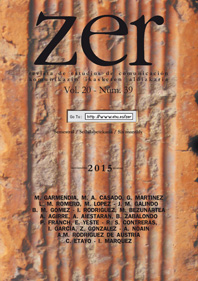Hollywoodeko ekoizpen kodea (1930 – 1966): zentsura, esparruak (frame-ak) eta hegemonia
##plugins.themes.bootstrap3.article.main##
##plugins.themes.bootstrap3.article.sidebar##
Argitaratua
09-12-2015
Alfonso Maximiliano Rodríguez de Austria
Laburpena
Ohiko pentsamoldeak dioenaren aurka, Hollywoodeko Ekoizpen Kodea ez zen Eliza katolikoaren inposizioa izan. Ezarri zuten indarrak ugariagoak eta boteretsuagoak ziren, eta euren xede nagusia gizartearen gain zuten hegemonia –nagusigo hori ahultzen ari zen unean– mantentzea zen. Arazo sozialak modu bakarrean interpretatzeko balioko zuketen oinarrizko erreferentzia esparruak sortzea zen statu quo ekonomiko eta ideologikoaren defentsarako gako nagusietako bat. Ikerlan honetan, kodearen ezartzea jorratzen dugu esparru hauen (frame analysis) analisiaren ikuspegitik.
Nola aipatu
Rodríguez de Austria, A. M. (2015). Hollywoodeko ekoizpen kodea (1930 – 1966): zentsura, esparruak (frame-ak) eta hegemonia. Zer. Komunikazio Ikasketen Aldizkaria, 20(39). https://doi.org/10.1387/zer.15533
##plugins.themes.bootstrap3.article.details##
References
BERGER, P. y LUCKMANN, T. (1991). La construcción social de la realidad. Buenos Aires: Amorrortu.
BERNSTEIN, Richard J. (2006). El abuso del mal. La corrupción de la política y la religión desde el 11/9. Buenos Aires: katz.
BLACK, Gregory. D. (1999a). Hollywood censurado. Madrid: Cambridge University Press.
BLACK, Gregory. D. (1999b). La cruzada contra el cine (1940-1975). Madrid: Cambridge University Press.
BOBBIO, Norberto; MATTEUCCI, Nicola (1981). Diccionario de Política. Madrid: Siglo XXI.
DOHERTY, Thomas (1999). Pre-Code Hollywood. Sex, Immorality, and Insurrection in American Cinema 1930-1934. Nueva York: Columbia University Press.
GITLIN, Todd. (2003). The Whole World is Watching. Mass Media in the Making and Unmaking of the New Left. Berkeley: University of California Press.
GOFFMAN, Erving (2006). Frame Analysis. Los marcos de la experiencia. Madrid: CIS.
LAKOFF, George (2007). No pienses en un elefante. lenguaje y debate político. Madrid: Complutense.
PHILLIPS, Patrick (2007). Spectator, audience and response. En. NELMES, Jill (Ed). Introduction to Film Studies, pp. 143-172. Londres: Routledge.
POPPER, Karl (1994). La sociedad abierta y sus enemigos. Barcelona: Paidós.
MAINER, Carmen (2013). El Cine Norteamericano durante la Gran Depresión (1929-1939). Fotocinema, Revista Científica de Cine y Fotografía, nº 6, pp. 171-200.
MICEVICIUTE, Jurate (2013). Frame periodístico. un concepto puente entre la Psicología, la Sociología y la Lingüística. Zer, vol. 18, nº 35, pp. 71-96.
MILLER, Toby et al. (2005). El nuevo Hollywood. Del imperialismo cultural a las leyes de marketing. Barcelona: Paidós.
ROFFMAN, Peter; PURDY, Jim (1981). The Hollywood Social Problem Film. Madness, Despair, and Politics from the Depression to the Fifties. Indiana University Press – Bloomington.
SÁNCHEZ RUIZ, Enrique E. (2003). Hollywood y su hegemonía planetaria. Una aproximación histórico-estructural. Guadalajara, nº 28 de la Colección de Babel de la Revista Universidad de Guadalajara.
SÁDABA, Teresa (2008). Framing. el encuadre de las noticias. El binomio terrorismo-medios. Buenos Aires: La Crujía.
BERNSTEIN, Richard J. (2006). El abuso del mal. La corrupción de la política y la religión desde el 11/9. Buenos Aires: katz.
BLACK, Gregory. D. (1999a). Hollywood censurado. Madrid: Cambridge University Press.
BLACK, Gregory. D. (1999b). La cruzada contra el cine (1940-1975). Madrid: Cambridge University Press.
BOBBIO, Norberto; MATTEUCCI, Nicola (1981). Diccionario de Política. Madrid: Siglo XXI.
DOHERTY, Thomas (1999). Pre-Code Hollywood. Sex, Immorality, and Insurrection in American Cinema 1930-1934. Nueva York: Columbia University Press.
GITLIN, Todd. (2003). The Whole World is Watching. Mass Media in the Making and Unmaking of the New Left. Berkeley: University of California Press.
GOFFMAN, Erving (2006). Frame Analysis. Los marcos de la experiencia. Madrid: CIS.
LAKOFF, George (2007). No pienses en un elefante. lenguaje y debate político. Madrid: Complutense.
PHILLIPS, Patrick (2007). Spectator, audience and response. En. NELMES, Jill (Ed). Introduction to Film Studies, pp. 143-172. Londres: Routledge.
POPPER, Karl (1994). La sociedad abierta y sus enemigos. Barcelona: Paidós.
MAINER, Carmen (2013). El Cine Norteamericano durante la Gran Depresión (1929-1939). Fotocinema, Revista Científica de Cine y Fotografía, nº 6, pp. 171-200.
MICEVICIUTE, Jurate (2013). Frame periodístico. un concepto puente entre la Psicología, la Sociología y la Lingüística. Zer, vol. 18, nº 35, pp. 71-96.
MILLER, Toby et al. (2005). El nuevo Hollywood. Del imperialismo cultural a las leyes de marketing. Barcelona: Paidós.
ROFFMAN, Peter; PURDY, Jim (1981). The Hollywood Social Problem Film. Madness, Despair, and Politics from the Depression to the Fifties. Indiana University Press – Bloomington.
SÁNCHEZ RUIZ, Enrique E. (2003). Hollywood y su hegemonía planetaria. Una aproximación histórico-estructural. Guadalajara, nº 28 de la Colección de Babel de la Revista Universidad de Guadalajara.
SÁDABA, Teresa (2008). Framing. el encuadre de las noticias. El binomio terrorismo-medios. Buenos Aires: La Crujía.
Zenbakia
Atala
Artikuluak
(c) UPV/EHU Press

